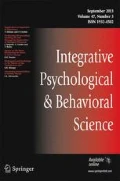Abstract
Since Frege, mental content (conscious content) has been distinguished from the meaning of natural language and not regarded mental content as the meaning of language expression. This anti-psychological view cuts off the connection between the meaning of language and mental content, giving rise to the failures in solving the problems of mind. Instead of thinking about linguistic meaning and mental content separately, philosophers of mind put more emphasis on mental content and even equate the meaning of linguistic expressions with it. Therefore, the issues that what the relationship between linguistic meaning and mental content is and how they are connected are not well answered so far. The author argues in this paper that: 1) People attach meaning to symbols through communication activities when they have mental contents, thus forming the language, which is also a process of achieving psychological certainty in turn; 2) the relationship between linguistic meaning and mental content is similar to the interdependent relationship between monetary value and the use value of commodities. Without the latter, the former will lose its source, and the former also affects the latter. Philosophers of mind pay little attention to the interplay between language and mental content. Based on the above arguments and previous theories, this paper conceives a general model of the generation of linguistic meaning.
Similar content being viewed by others
References
Blumer, H. (1969). Symbolic Interactionsim: Perspective and Method. Berkeley: University of California Press.
Carter, M. J., & Fulle, C. (2015). Symbolic interactionism. Sociopedia.isa, https://doi.org/10.1177/205684601561.
Chiesa, C. (1997). Wittgenstein et la fin du psychologisme. Revue Philosophique de la France et de l’Étranger, 187(2), 183–194.
Davidson, D. (1984). Theories of Meaning and Learnable Languages. In Inquiries into Truth and Interpretation (pp. 3–16). New York: Clarendon Press.
Dummett, M. (1973). Frege: Philosophy of Language. New York: Harper and Row.
Dummett, M. (1993a) What is a Theory of Meaning?(II). In The Seas of Language (pp. 34–93). Oxford: Clarendon.
Dummett, M. (1993b). Origins of Analytical Philosophy. London: Bloomsbury.
Fllesdal, D. (1999). Mind and Meaning. Philosophical Studies, 94(1), 139–149.
Fodor, J. (1975). The Language of Thought. New York: Thomas Y. Crowell.
Fodor, J. (1994). The Elm and the Expert. Cambridge: The MIT Press.
Fodor, J., & Pylyshyn, Z. (1988). Connectionism and Cognitive Architecture: A Critical Analysis. Cognition, 28, 3–71.
Frege, G. (1960). On sense and reference. In P. Geach & & M. Black (Eds.), Translations from the philosophical writings of Gottlob Frege (pp. 56–78). Oxford: Basil Blackwell.
Gunther, Y. H. (2003). Essays on Nonconceptual Content. Cambridge, Mass: The MIT Press.
Harman, G. (1973). Thought. Princeton: Princeton University Press.
Harnad, S. (1990). The symbol grounding problem. Physica D: Nonlinear Phenomena, 42(1–3), 335–346.
Katz, M. (2020). The Language of Thought Hypothesis. Internet Encyclopedia of Philosophy. Online at https://www.iep.utm.edu/lot-hypo/
Kind, A. (2020). Qualia. Internet Encyclopedia of Philosophy. Online at https://www.iep.utm.edu/qualia/
Kneale, W., & Kneale, M. (1962). The Development of Logic. Oxford: Clarendon Press.
Lohmar, D. (2006). Mirror Neurons and the Phenomenology of Intersubjectivity. Phenomenology and the Cognitive Sciences, 5, 5–16.
Ludwig, K. (2003). Donald Davidson. New York: Cambridge university press.
Lund, N. (2003). Language and Thought, London; New York: Routledge.
Mead, G. H. (1934). Mind, Self, and Society: from the Standpoint of a Social Behaviorist. Chicago: University of Chicago Press.
Millikan, R. G. (1998). Language conventions make simple. Journal of Philosophy, 95(4), 161–180.
Millikan, R. G. (2004). Varieties of Meaning. Gambridge: the MIT Press.
Müller, V. C. (2009). Symbol Grounding in Computational Systems: A Paradox of Intentions. Minds and Machines, 19(4), 529–541.
Pataut, F. (1996). An Anti-Realist Perspective on Language, Thought, Logic and the History of Analytic Philosophy: An Interview with Michael Dummett. Philosophical investigations, 19(1), 1–33.
Peacocke, C. (2001). Does Perception Have a Nonconceptual Content? Journal of Philosophy, 99, 239–264.
Pitt, D. (2020). Mental Representation. Stanford Encyclopedia of Philosophy. Online at https://plato.stanford.edu/entries/mental-representation/
Quine, W. V. O. (1951). Two Dogmas of Empiricism. Philosophical Review, 60: 20–43. Reprinted in From a Logical Point of View, pp. 20–46.
Reed, B. (2008). Certainty. Stanford Encyclopedia of Philosophy. Online at https://plato.stanford.edu/entries/certainty/.
Rescorla, M. (2019). The Language of Thought Hypothesis. Stanford Encyclopedia of Philosophy. Online at https://plato.stanford.edu/entries/language-thought/.
Rescorla, M. (2020). The Computational Theory of Mind. Stanford Encyclopedia of Philosophy. Online at https://plato.stanford.edu/entries/computational-mind/.
Roth, W.-M., & Lee, Y.-J. (2007). “Vygotsky’s Neglected Legacy”: Cultural-Historical Activity Theory. Review of Educational Research, 77(2), 186–232.
Russell, B. (1905), On Denoting. Mind, 14: 479–493. Reprinted in Bertrand Russell, Logic and Knowledge, London: George Allen and Unwin, 1956, 41–56.
Searle, J. (1980). Minds, Brains, and Programs. Behavioral and Brain Sciences, 3, 417–457.
Smagorinsky, P. (2001). If Meaning Is Constructed, What Is It Made from? Toward a Cultural Theory of Reading. Review of Educational Research, 71(1), 133–169.
Speaks, J. (2019). Theories of meaning. Stanford Encyclopedia of Philosophy. Online at https://plato.stanford.edu/entries/meaning/.
Taddeo, M., & Floridi, L. (2007). A praxical solution of the symbol grounding problem. Minds and Machines, 17(4), 369–389.
Tye, M. (2017). Qualia. Stanford Encyclopedia of Philosophy. Online at https://plato.stanford.edu/entries/qualia/.
Vygotsky, L. (1986). translation newly revised and edited by Alex Kozulin. Thought and Language. Cambridge, Massachusetts; London England: The MIT Press.
Wittgenstein, L. (1958). Philosophical Investigations, G.E.M. Anscombe and R. Rhees (eds.), G.E.M. Anscombe (trans.), Oxford: Blackwell.
Wittgenstein, L. (1969). On Certainty. G. E. M. Anscombe and G. H. von Wright (Eds.), G.E.M. Anscombe and D. Paul (trans.), Oxford: Blackwell.
Acknowledgments
This financial support is provided by Major Program of National Fund of Philosophy and Social Science of China (18ZDA032).
Author information
Authors and Affiliations
Corresponding author
Additional information
Publisher’s Note
Springer Nature remains neutral with regard to jurisdictional claims in published maps and institutional affiliations.
Rights and permissions
About this article
Cite this article
Huo, S. Bridging the Gap between the Meaning of Natural Language and Mental Content. Integr. psych. behav. 56, 163–179 (2022). https://doi.org/10.1007/s12124-020-09596-3
Accepted:
Published:
Issue Date:
DOI: https://doi.org/10.1007/s12124-020-09596-3



